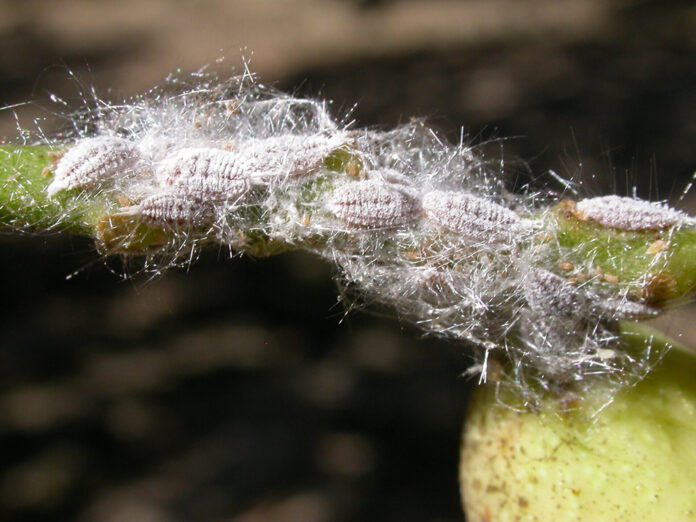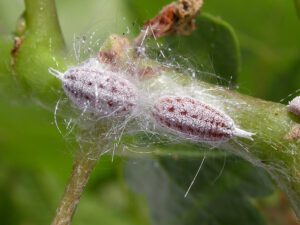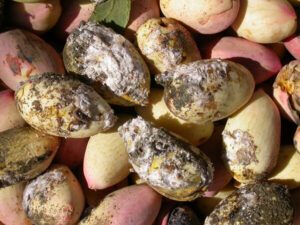
Gill’s mealybug has become a formidable foe for many pistachio growers with no effective biological control and with the pest becoming less sensitive to two insecticides in parts of the state.
Confounding management are the European Union’s tight maximum residue limits for some of the effective chemical controls, said David Haviland, UCCE integrated pest management advisor in Kern County.
“Just be really, really, really careful,” he told attendees at a recent Sacramento Valley pistachio growers meeting. “There have been crop residues over tolerance when used according to label, particularly on pistachios.”
Left untreated, Gill’s mealybug may reduce the percentage of splits, reduce kernel size and overall yields, increase staining on the second shake, increase stick tights and create more gumming in trailers.
The problem appears to be more severe in the southern San Joaquin Valley than in the Sacramento Valley. UCCE IPM Advisor Sudan Gyawaly, who covers six counties from Yuba and Sutter north, said he hadn’t received any phone calls from growers or PCAs about the pest in the two years he has worked in the north-state. But that doesn’t mean the pest isn’t there.

He suspected the quiet phones were due to significantly less pistachio acreage in his area compared to the south San Joaquin Valley. Gyawaly talked to three north-state PCAs who handled pistachios, and all had seen the pest to varying degrees.
One had a pistachio block with low to moderate infestations. Another with more pistachio acreage said the pest pressure fluctuated from year to year. And the third had only seen Gill’s mealybug once.
Regardless, Gyawaly said growers should be careful bringing in equipment and bins from other potentially infested orchards because the pest can easily hitchhike on them.
“When you bring in equipment, be very careful about washing them,” he said. “The PCAs [I talked to] have very strong preventive measures in place.”

Is It a Gill’s or a Grape Mealybug?
Likely native to the southeastern United States, Gill’s mealybug, known scientifically as Ferrisia gilli, was first identified in Pixley and Tulare pistachio orchards in 2003. Since then, it has spread pretty much throughout the state.
Like other mealybug species, only the male Gill’s mealybug has wings. The female and immature are wingless and reasonably mobile, but they can’t move too far or too fast.
They also can hitchhike on harvest equipment, bins and other items and spread within an orchard or from orchard to orchard.
For nearly two decades, researchers have studied the pest, but much of current management is based on research conducted in 2005, Haviland said.
Grape mealybugs also can be found in pistachio orchards, but they typically are not economic pests. To differentiate the two, female grape mealybugs have four slender white tails whereas female Gill’s mealybugs have two broader white tails.
When poked, adult female grape mealybugs exude a bright red liquid through openings near the rear, but Gill’s mealybugs won’t. In addition, immature grape mealybugs hatch from egg sacs and usually crawl away from their mother. Gill’s mealybugs, on the other hand, have live births, and the immatures stay around the female.
The cause for concern is Gill’s mealybug feeding habits and shear numbers. Researchers have found they have three generations in the state, increasing exponentially with each one.
Using piercing-sucking mouthparts, they feed on phloem from buds and pistachio clusters and excrete honeydew. The sticky sugar-containing substance attracts black sooty mold.
During feeding, the mealybugs extract carbohydrates and other nutrients, potentially decreasing kernel size and increasing shell staining. In severe cases, it also can cause nuts to shrivel on the tree, creating potential overwintering sites for navel orangeworm.
Winter and Early Spring Habits
Gill’s mealybugs overwinter as nymphs under the trunk bark, including the trunk base. But Haviland said very few survive through to spring. During budbreak in late March or early April, overwintering nymphs migrate up the tree to where the old wood meets new tissue and begin to feed. This coincides with when the tree begins to transport stored carbohydrates from the roots.
By late April in the San Joaquin Valley, adults begin to emerge, with females beginning to give birth in late May. This is when populations can begin to build.
From May through September, mealybugs are found almost exclusively in the clusters.
September also is when the females will produce the third generation, which will overwinter as crawlers around the tree base.
This is a good time to scout trees for wet-looking areas of the bark caused by honeydew. Also pay attention to black sooty mold on leaves. Mark areas with infestations so you can return the following spring to recheck for mealybugs.
After harvest, females typically migrate back down to the trunks and main scaffolds, where they’ll form white, fuzzy-looking aggregations. Also mark these so you can return in the spring and look for clusters of females.
Mealybug Management
In mid-May, begin scouting weekly, checking for adult females on the rachis and for crawlers.
A three-year research trial found an economic threshold of one mealybug per every 10 clusters in May based on a $60-per-acre treatment and 3,000-pound anticipated yields. Haviland said the economic threshold may vary based on pistachio price, expected yields and insecticide costs.
For growers who need to treat, he recommended a late May-early June timing to target first-instar crawlers. This is the most sensitive growth stage because the youngsters aren’t covered in protective waxy secretions as older ones or adult females are.
In the past, a single application typically was enough to keep most populations below economic thresholds for the remainder of the season. But more recently, many growers have found the first spray is less effective than it used to be and that they need a second one to reduce mealybug populations.
Although Centaur WDG, an insect growth regulator (IGR) that contains the active ingredient buprofezin, has been a top performer in trials, Haviland cautioned about EU residue concerns at harvest. As a result, he recommended against using Centaur after mid-April if growers know their crop will be exported or if they’re unsure of the market destination. For growers who know their crop will remain in domestic markets, he said one properly timed treatment of the IGR may provide season-long control.
Assail 70WP and Movento 240SC also have performed well in trials, Haviland said. Under severe infestations, a clean-up spray applied to the second generation of crawlers in late July may be warranted. A Movento application in late May followed by Assail in July worked well in trials.
To slow resistance from developing, he recommended rotating effective modes of action. If growers are only applying one mealybug treatment per year, he recommended using Assail one year and changing to Movento the following season or vice versa.
In some areas of the state, resistance is already happening with Movento, which contains the active ingredient spirotetramat.
“We’re starting to see Movento decline,” Haviland said. “Where we got a 50% reduction a couple years ago, we only got about a 20% reduction last year. We’ve documented its resistance. It’s actually getting serious in some orchards in some parts of the Central Valley.”
Haviland also was part of a 2021 study that examined baseline susceptibility of Gill’s mealybug to Assail, which contains the active ingredient acetamiprid. The researchers found reduced sensitivity within a population collected near Hanford compared to other populations from the South San Joaquin Valley. The findings further backed the need to manage insecticides to slow resistance.

Vicky Boyd | Contributing Writer
A veteran agricultural journalist, Vicky Boyd has covered the industry in California, Florida, Texas, Colorado, the South and the Mid-South. Along the way, she has won several writing awards. Boyd attended Colorado State University, where she earned a technical journalism degree with minors in agriculture and natural resources. Boyd is known for taking complex technical or scientific material and translating it so readers can use it on their farms. Her favorite topics are entomology, weeds and new technology. When she’s not out “playing in the dirt,” as she calls agricultural reporting, Boyd enjoys running, hiking, knitting and sewing.















